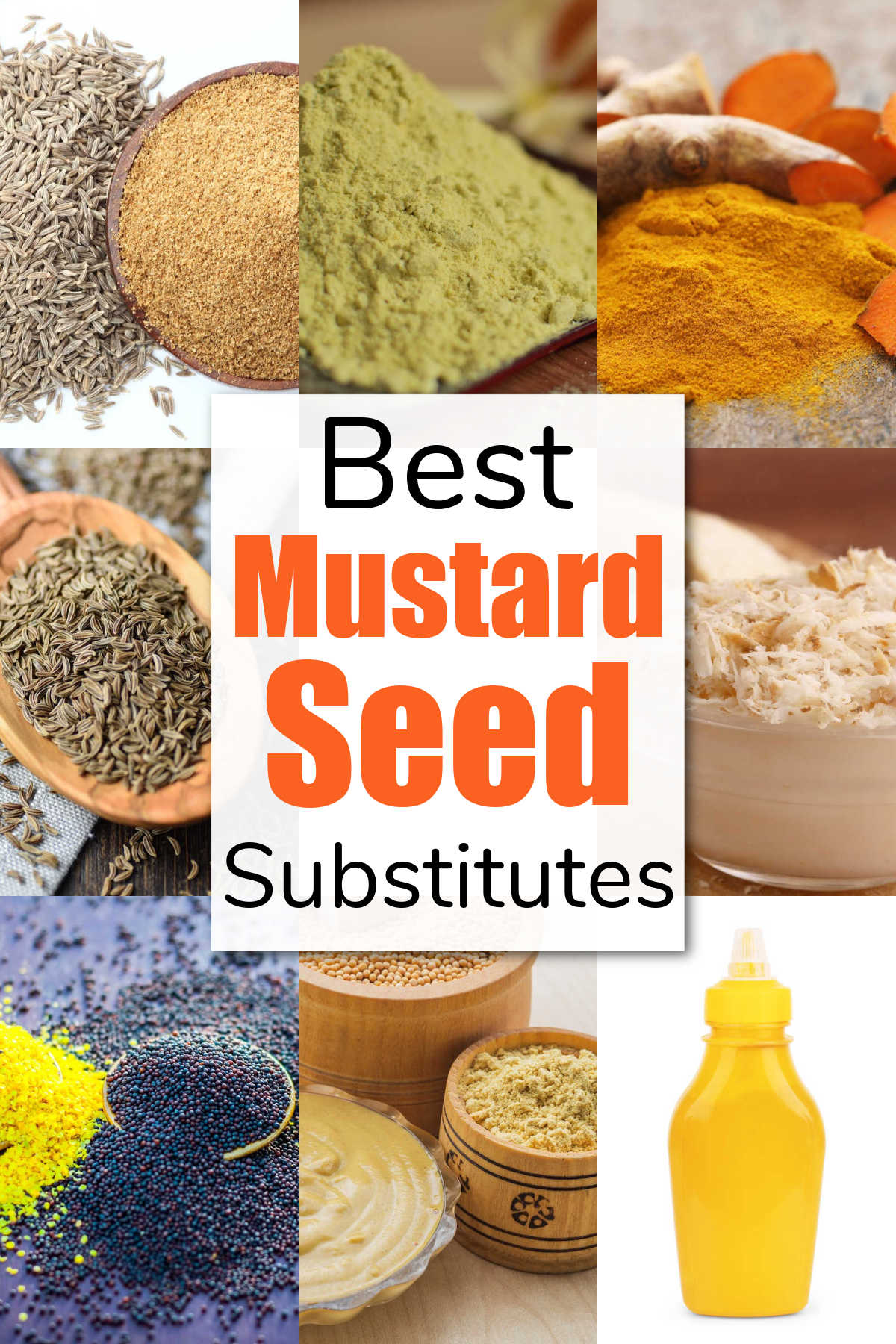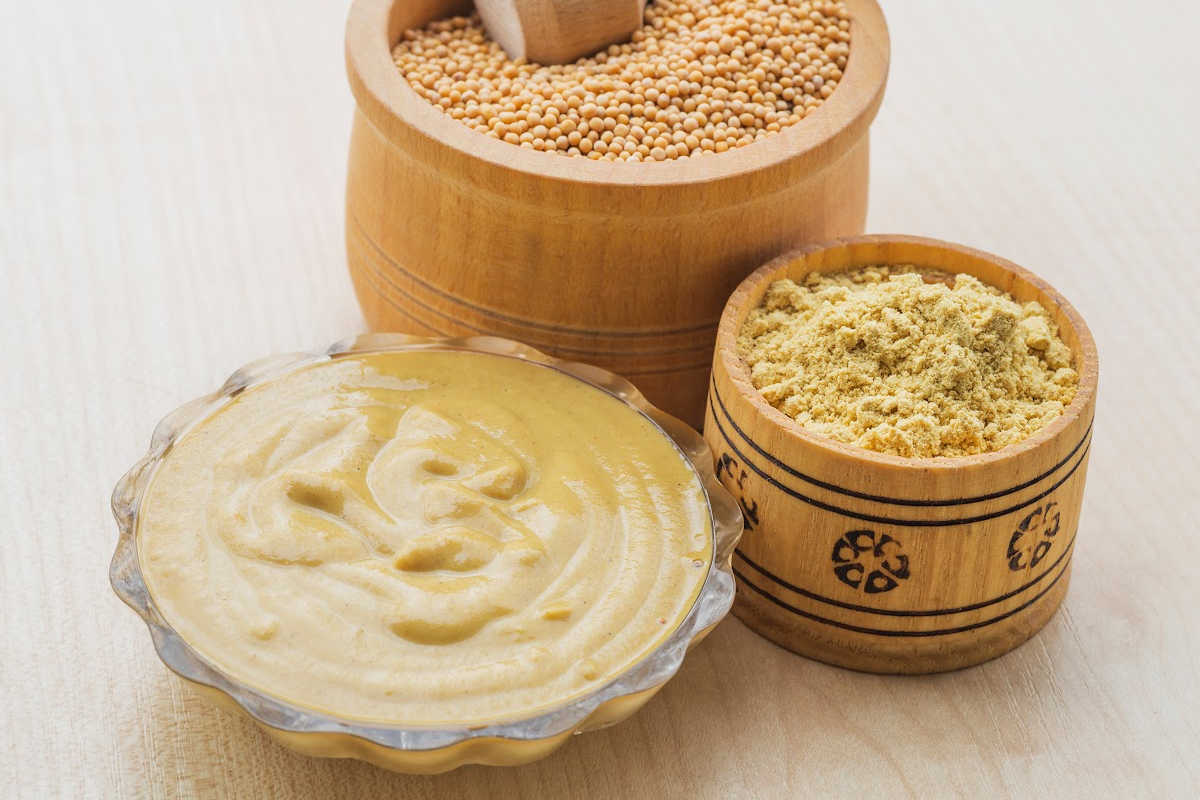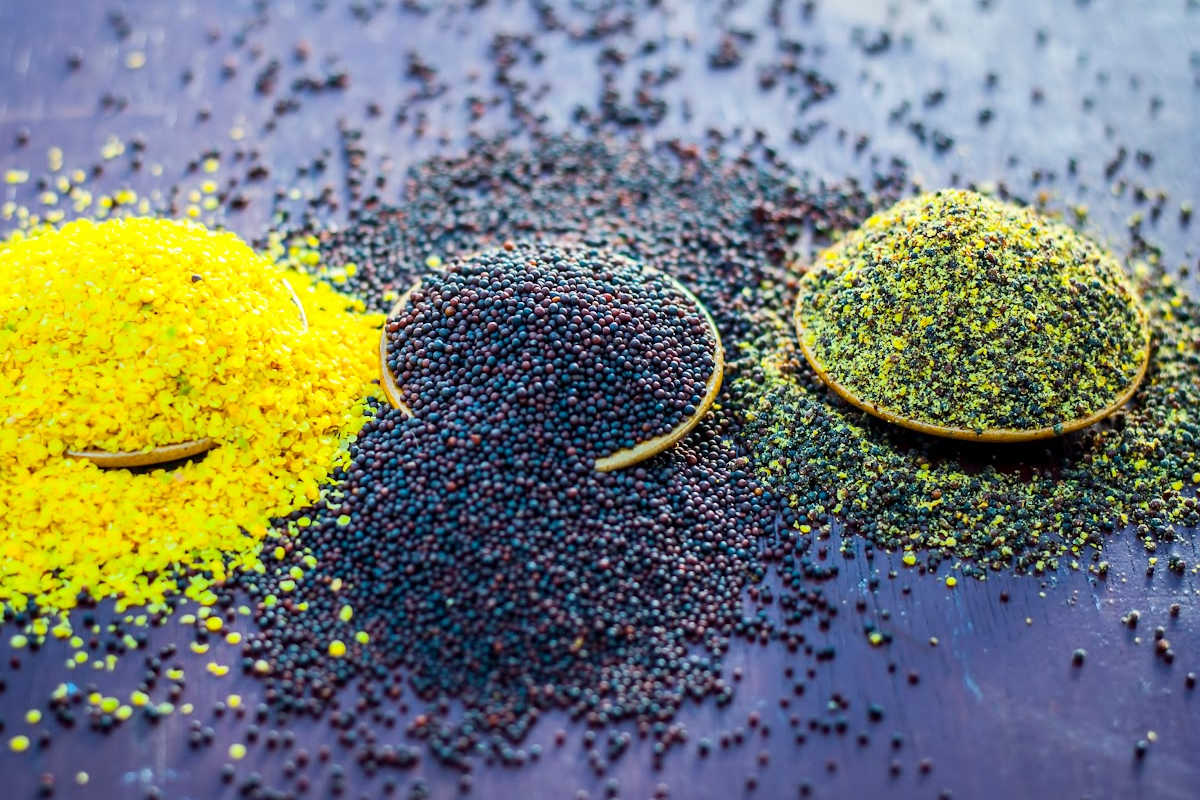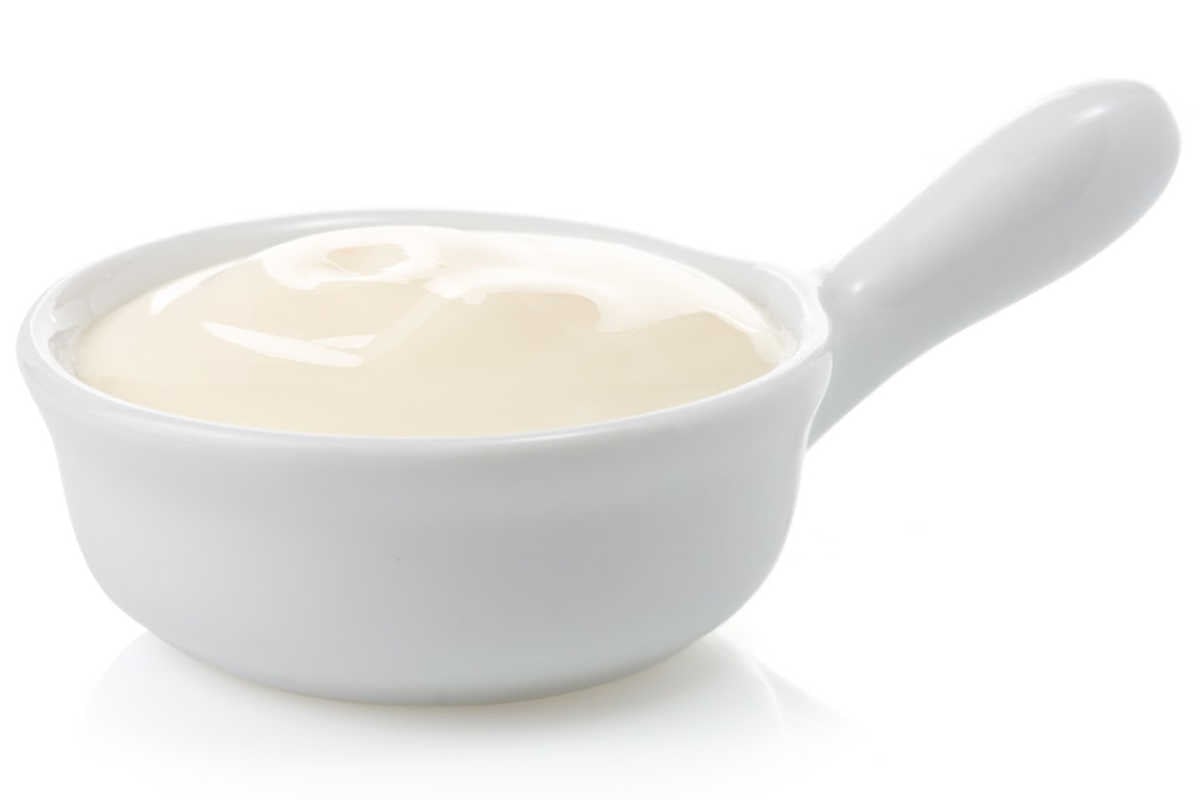These are the Best Mustard Seed Substitutes when you are looking for alternatives without rushing to the store to purchase a spice you aren’t sure you will use often.

Mustard is one of the most popular condiments on the planet and we use it in tons of recipes and in a wide range of forms from prepared bottles to simple seeds.
The problem is, while prepared mustard is easily found, it’s hard to say the same for mustard seeds, and that’s where this guide hops in for the rescue!
If your recipe calls for mustard seed but you can’t find any, keep on reading as I walk you through some of the most common mustard seed substitute ideas that you can find out there!
🥣 What Exactly Is Mustard Seed?
Before diving into the juicy details of the substitutes and how to adjust them so you can use the mustard, let’s have a quick look at what mustard seed exactly is.
For starters, you should know that mustard refers to a group of plant species of the Brassica and Sinapis families and not just one plant.
As the name suggests, mustard seeds are the flowering seeds produced by the mustard plant, which are edible like all other parts of the plant.
While there are numerous types of mustard throughout the world, but there are three prominent types that make up the majority of worldwide sales, which are:
- White Mustard (Sinapis alba)
- Black Mustard (Brassica nigra)
- Brown Mustard (Brassica juncea)
While the three types have different notes, mustard seeds, in general, have a remarkably pungent and sharp flavor, especially after processing and mixing with other ingredients like vinegar, lemon juice, or even certain alcohols.
✔️ Overview and Conversion Rates
If you’re in a hurry, here’s a summary list of all the substitutes mentioned in this guide and the conversion rates of each of them:
| Substitute | Ratio | Notes |
|---|---|---|
| Yellow Mustard | 1:3 | 1 teaspoon yellow mustard = 1 tablespoon mustard seeds |
| Ground Mustard | 1:1 | Don’t overfill the spoon to avoid extra bitterness |
| Other Types of Mustard Seeds (Black:Brown:Yellow(White)) | 1:2:4 | – |
| Horseradish (fresh or prepared) | 1:1 | – |
| Mayonnaise | 1:1 (up to 1 tablespoon) | Best for soups and sauces. |
| Caraway Seed | 1:1 | – |
| Turmeric Powder | 1:1 | You may also add 1/2 teaspoon of horseradish to give the flavor a kick. |
| Wasabi | 1:2 | – |
| Cumin Seeds (whole or ground) | 1:1 | Lightly toast the cumin seeds before using them, just like you would mustard seeds, for a deeper and richer flavor. |
| Pickling Spice | 1:1 | Add more if needed. |
🔪 Alternatives and How to Use Them
Now that you know more about mustard seeds, let’s have a quick look at some of the options you may consider if you don’t have the one that your recipe calls for.
That being said, you should know that some of these substitutes might be better suited for specific purposes, so you should pick the ones that work best for your requirements.
Yellow Mustard

Let’s start with one of the easiest ways to replace your mustard seeds. Yellow mustard refers to regular bottled mustard, and of course, switching to this alternative should work in many recipes.
Keep in mind that yellow mustard is usually more potent despite lacking the bitter profile of mustard seeds.
Therefore, you should replace every 1 tablespoon of mustard seeds with 1 teaspoon of mustard (ie. 1/3 the amount).
Also, you might need to reduce the amount of other liquid ingredients used in your recipe to compensate for the added mustard.
Mustard Powder

Ground or dry mustard is one of the best mustard seed substitutes, simply because ground mustard is the powder form of the same thing. You can find ground mustard in the condiments section of large grocery stores.
Since they’re exactly the same thing, you should usually replace each 1 tablespoon of mustard seeds with 1 tablespoon of mustard powder. However, make sure that you don’t overfill the spoon to avoid extra bitterness.
Tip: Mustard powder is an excellent ingredient and mustard seed substitute for rubs and marinades. Try it in our amazing Instant Pot Ribs recipe for an effortless meal you won’t forget!
Other Types of Mustard Seeds

Some people might be hesitant to use other types of mustard seeds if their recipe calls for a specific type.
For example, if your recipe calls for brown mustard seeds, you can replace them with white (yellow) or black mustard seeds.
However, you should know that black is the most potent variety of mustard, so it’s considered twice as potent as the brown and four times as potent as the yellow, so keep that in mind while doing your conversions.
Horseradish

Horseradish is an excellent alternative to mustard seeds if you want to make your recipe a little spicier or hotter.
While they differ greatly in texture, the difference in pungency profile between horseradish and mustard seeds is pretty close, as they belong to the same family of plants.
Even better, the subtle differences between the flavors of the two diminish after they are mixed with other ingredients.
You can use any kind of horseradish as a substitute, whether you’re using fresh horseradish or prepared horseradish in jars. In both cases, you should use horseradish in a 1:1 ratio while converting.
Enjoy this pungent root in a delicious horseradish sauce that pairs up with steak nicely.
Mayonnaise

There are plenty of soups where yellow mustard seeds are added to increase the consistency of the recipe and add a slight touch of zestiness.
If you’re making a soup and want to achieve the same consistency without much emphasis on the flavor (you’re using other spices, for example), replacing mustard seeds with a little bit of mayonnaise may work.
In that case, you should add just a small amount of mayonnaise so you can thicken the soup without altering the flavor, up to one tablespoon.
Note: You’ll also find yellow mustard seeds in the creation of several types of homemade mayonnaise recipes. It is mild and helps the mayo not break down as easily.
Caraway Seed

If you’re using mustard seeds for both flavoring and topping, you need an alternative that has a similar flavor profile as well as texture. In that case, your best bet would be using caraway seeds.
The seed form helps in thickening many dishes and soups.
It is surprisingly similar in flavor, especially if you’re replacing yellow mustard seeds. Use caraway seeds in a 1:1 ratio.
Turmeric Powder

Turmeric powder is one of the main reasons prepared yellow mustard got its color, so it’s no surprise that turmeric powder itself can be an excellent substitute for mustard in a variety of forms, including its seeds.
It’s perfect for dishes rich in veggies like these easy vegan stewed chickpeas.
By adding turmeric powder instead of yellow mustard, you’ll give your recipe a little more of that yellow color and retain the unique peppery taste.
You can use one tablespoon of turmeric for every tablespoon of mustard seeds in your recipe, but since it’s slightly milder, you may also add ½ teaspoon of horseradish to give the flavor a kick.
Wasabi

If you mainly use mustard seeds to increase the heat of the recipe and make it extra spicy, you can use wasabi instead. This Asian cuisine staple has a flavor profile that’s very similar to horseradish and mustard seeds.
This green flavoring is available in both dry powder and paste forms. In both cases, wasabi is remarkably spicier than mustard seeds, especially when compared with the common yellow mustard seeds.
For that reason, you should usually use half the amount required in the recipe when replacing it with wasabi.
Cumin Seeds

You can also use cumin seeds to replace mustard seeds.
Although it doesn’t exactly match the taste profile, cumin seeds are still spicy and slightly pungent, so it’s a good alternative for those who want to try something a little different.
Cumin seeds, whole or ground, work as a 1:1 substitute for mustard seeds.
It’s a good idea to lightly toast the cumin seeds before using them, just like you would mustard seeds. This will give them a deeper and richer flavor.
Cumin complements dishes with beans. Try it in our crockpot refried beans and air fryer taquitos recipes!
Pickling Spice
This spice blend with a straightforward name has mustard seeds as one of the ingredients. They also contain coriander seeds, allspice, ginger, bay leaves, cinnamon, red pepper flakes, and cloves.
As a mustard seed substitute, pickling spice can be used for various dishes, and of course, actual pickles!
A 1:1 ratio makes a good place to start when swapping mustard seeds for pickling spice. You can always add more later if needed.
Recipes with Mustard Seed
Sauteed Cauliflower with Mustard Seeds– This recipe uses mustard seed to pack a punch of flavor to sautéed cauliflower. Use the same concept on other veggies that are grilled or roasted as well.
Patra – This one is a South Asian vegetarian recipe that is prepared with Patra leaves in addition to a wide range of condiments, including mustard seeds.
Indian Potatoes – Another vegetarian recipe that adds a lot of flavor to plain potatoes and is garnished with different types of mustard seeds.
Dosas and Samosas – Both recipes are fried or baked pastries that can be filled with a variety of vegetables and meats.
❓ Frequently Asked Questions
As long as you’re consuming mustard seeds within safe limits per day, it can actually be beneficial.
In fact, some studies link between the use of mustard and fighting cancerous cells in addition to its ability to reduce blood sugar levels as well as preventing some bacterial infections.
On the other hand, consuming too much mustard can cause some digestive problems, such as diarrhea, intestinal inflammation, and abdominal pain.
Yes, mustard seeds are the key ingredient while making yellow mustard sauce or
paste that is available in bottled form.
Yellow mustard is prepared from white mustard seeds. The seeds are usually ground into powder and mixed with water and vinegar in addition to lemon, turmeric (which gives mustard its yellow color), and other spices to create the zesty pungent condiment.
Mustard seeds can be added plain, straight from the container or you can fry them first.
Heat up a skillet with oil on high. After it is really hot, add a small amount of mustard seeds. You will see them “pop” within a few seconds. Remove them right away and let them drain on a paper towel.
These are a fantastic garnish and add a complex flavor to salads and other dishes.
Mustard seeds are a common ingredient in curries. The best mustard seed substitutes for curry are cumin seeds and fenugreek seeds.
Cumin has a very strong flavor so start with half of the amount when substituting mustard seeds. Fenugreek seeds can be used as a 1:1 replacement.
For pickling mustard seeds can be replaced by mustard powder. The only notable difference is the powdered form of mustard will cloud the pickling liquid.
Other alternatives include horseradish, wasabi, cumin, and caraway seeds. None of these substitutes will cloud the liquid for pickling.
When making a salad dressing you can use mayonnaise, or oil and vinegar to replace mustard seeds. In some cases, you can simply skip the mustard seeds.
If your recipe calls for Dijon mustard or spicy brown mustard, they can be replaced with a small amount of prepared horseradish or wasabi.
📄 The Bottom Line
With that said, you now have a brief guide that shows you several options to consider if you’re looking for a mustard seed substitute.
Of course, the easiest option would be using different types of mustard seeds, as they share similar flavor profiles.
Related Articles
Hi!
Ginny Collins is a passionate foodie and recipe creator of Savor and Savvy and Kitchenlaughter. Indoors she focuses on easy, quick recipes for busy families and kitchen basics. Outdoors, she focuses on backyard grilling and smoking to bring family and friends together. She is a lifelong learner who is always taking cooking classes on her travels overseas and stateside. Her work has been featured on MSN, Parade, Fox News, Yahoo, Cosmopolitan, Elle, and many local news outlets. She lives in Florida where you will find her outside on the water in her kayak, riding her bike on trails, and planning her next overseas adventure.








Leave a Reply